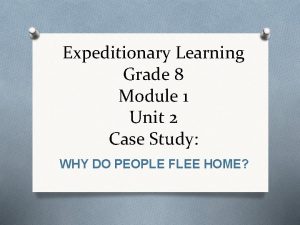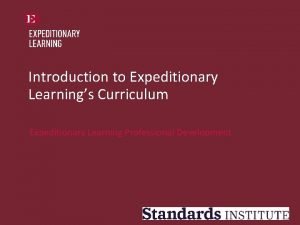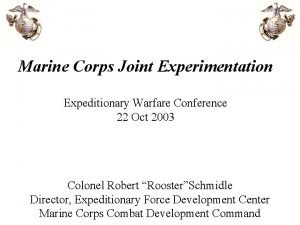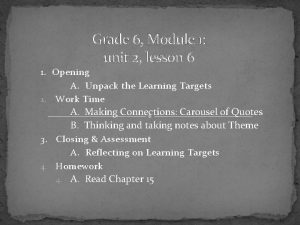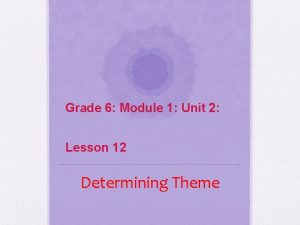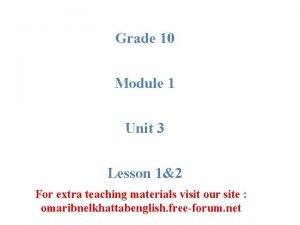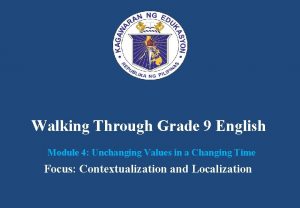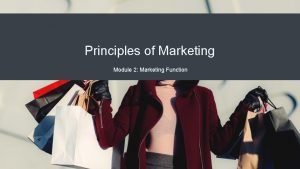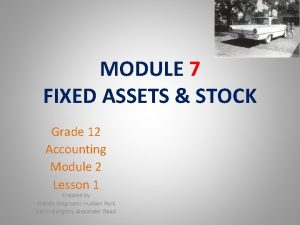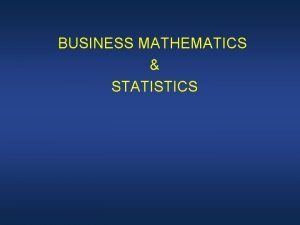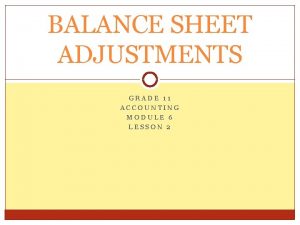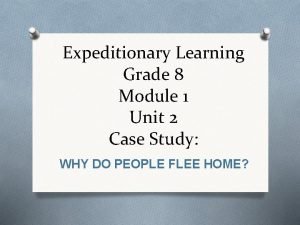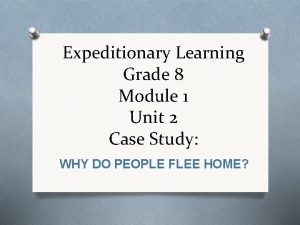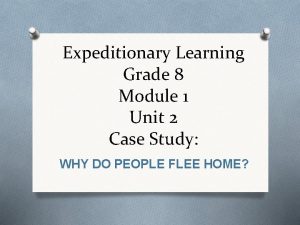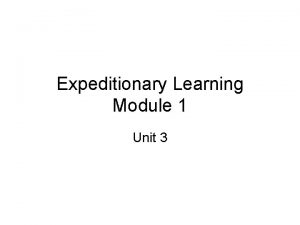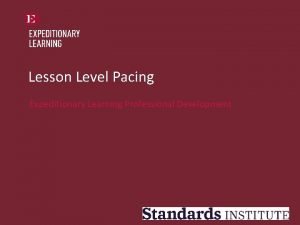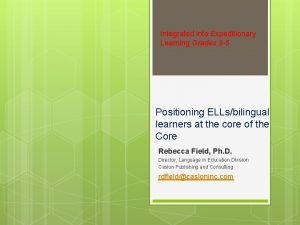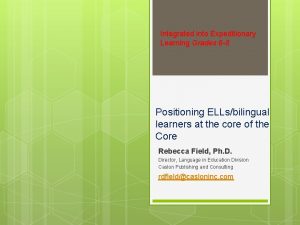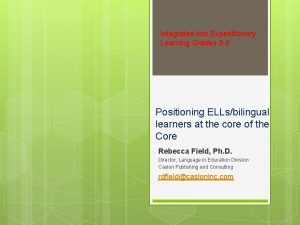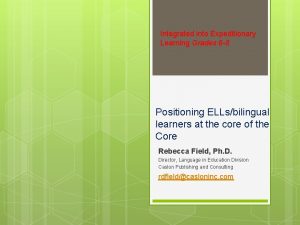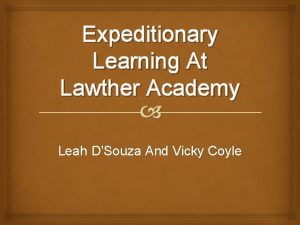Expeditionary Learning Grade 8 Module 1 Unit 2














- Slides: 14

Expeditionary Learning Grade 8 Module 1 Unit 2 Case Study: WHY DO PEOPLE FLEE HOME?

Lesson #10 Analyzing the Significance of the Novel’s Title: Connecting the Universal Refugee Experience to Inside Out & Back Again

Learning Objective: • Students will relate some of the challenges faced by the real -life refugee and immigrant children to Ha’s experiences when she arrives in Alabama by connecting a poem from Inside Out & Back Again to the real-life refugee experiences in “Refugee and Immigrant Children: A Comparison. ” • CCLS: O I can cite text-based evidence that provides the strongest support for my analysis of literary text. (RL. 8. 1) O I can cite text-based evidence that provides the strongest support for an analysis of informational text. (RI. 8. 1) O I can read above-grade informational texts with scaffolding and support. (RI. 8. 10)

Lesson Vocabulary O strongest evidence O dependency reversal O discrimination O racism O “Rainbow”: lacquer, barrettes O “Loud Outside”: pluck O “More Is Not Better”: stalking

Warm Up: Engaging the Reader O Take out sticky notes. O Record the strongest pieces of evidence that you found from pages 237– 247 that reveal an aspect of Ha’s dynamic character. *How is Ha changing? *Where do your details best fit? *Do they show Ha turning “inside out” or coming “back again”? Put your sticky note on either the Inside Out anchor chart or the Back Again anchor chart, based on which your evidence is most relevant to.

LEARNING TARGETS: O I can use the strongest evidence from the novel and from the informational text to support my answers to Think-Pair-Share: *What does the strongest questions. evidence mean? O I can make connections between evidence of the universal refugee experience and the title of the novel Inside Out & Back Again.

Jigsaw Part 1: Pairs Reread First Paragraph of “Refugee and Immigrant Children: A Comparison” and Connect to a Poem from the Novel with Text-Dependent Questions O Turn to Lesson 10 of your curriculum binder. What does it mean to have a disruptive loss to one’s life? What disruptive loss has Ha faced in the novel Inside Out & Back Again? Today you will continue to build on this idea of the “disruptive loss” faced by refugees and immigrants.

O Turn to the “Refugee and Immigrant Children: A Comparison”: Paragraph 1 Text-Dependent Questions, Part B on Lesson 10 of your curriculum binder. O You are going to use these questions and make notes to dig deeper into Paragraph 1 of “Refugee and Immigrant Children: A Comparison” to better understand it. You are going to relate some of the challenges faced by the real-life refugee and immigrant children to Ha’s experiences when she arrives in Alabama. O You will work in pairs. Each pair will be assigned one poem from the novel to connect to the real-life refugee experiences in “Refugee and Immigrant Children: A Comparison. ”

Questions The informational text says: “Once in Canada, they both have to endure the ‘push-and-pull’ forces of home and school, which often work in opposite directions. ” How do the forces of home and school push and pull refugee and immigrant children in opposite directions? What challenges do refugee and immigrant children face at school? The informational text says: “Both refugee and immigrant children may encounter society’s discrimination and racism. ” What is discrimination and racism? The informational text says: “At home, both groups may experience a role and dependency reversal, in which they may function as interpreters and “cultural brokers” for their parents. ” What does dependency reversal mean? Notes Connections: Specific Details from Inside Out & Back Again

Poems to Read O “Rainbow” (page 142) O “Loud Outside” (page 145) O “More Is Not Better” (page 168) O Directions: O Reread the first paragraph of “Refugee and Immigrant Children: O O O A Comparison. ” Think about the questions. Discuss your thinking with your partner. Then write your thinking down in the center column. On your own, reread your pair’s assigned poem. With your partner, discuss your thinking about the key details in the poem. Then write your thinking down in the right-hand column.

Jigsaw Part 2: Group Discussion to Determine Whether the Issues Are “Inside Out” or “Back Again” O Take five minutes to share within your groups. Record new evidence from other poems on your question sheet. O Discuss and record an answer to the synthesis questions on Lesson 10 of your curriculum binder -Text-Dependent Questions, Part B. O The final sentence of this paragraph of the informational text says: “Perhaps the greatest threat to these children is not the stress of belonging to two cultures but the stress of belonging to none. ” What is the author saying is the biggest problem, bigger than all of the others in this paragraph? Is the author saying this will always be the case? What evidence do you have to answer that question?

Closing: Adding to the Inside Out and Back Again Anchor Charts O Let’s share some of your details from the informational text and the poem and to justify whether you think the details show turning “inside out” or “back again. ” O Record on Inside Out or Back Again anchor charts according to your classmates’ suggestions.

Homework Complete a first read of pages 248– 260. Take notes using the Structured Notes graphic organizer. Focus on key details and the strongest evidence that reveals Ha’s dynamic character and the challenges she is facing, plus new or important vocabulary that helps you understand the specific challenges of refugees.

Homework Vocabulary O intermingling (mix together) (257) O glutinous (sticky like glue in texture) (257)
 Grade 8 module 1
Grade 8 module 1 Expeditionary learning curriculum
Expeditionary learning curriculum Ndia expeditionary warfare conference
Ndia expeditionary warfare conference Ndia expeditionary warfare conference
Ndia expeditionary warfare conference Grade 8 module 1 unit 1 lesson 6 answer key
Grade 8 module 1 unit 1 lesson 6 answer key Grade 6 module 1: unit 2 answer key
Grade 6 module 1: unit 2 answer key What is sand made of
What is sand made of Cuadro comparativo entre e-learning b-learning y m-learning
Cuadro comparativo entre e-learning b-learning y m-learning C device module module 1
C device module module 1 Unit 6 review questions
Unit 6 review questions Grade 10 english module 4 pre test answer key
Grade 10 english module 4 pre test answer key Principles of marketing module 1
Principles of marketing module 1 Grade 12 accounting fixed assets
Grade 12 accounting fixed assets Business math grade 11 ratio and proportion
Business math grade 11 ratio and proportion Grade 11 accounting module 1
Grade 11 accounting module 1
